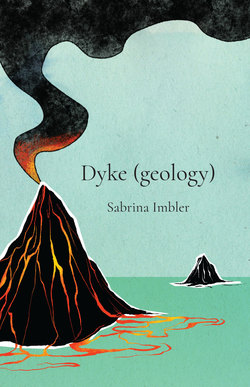Dyke (geology)

Реклама. ООО «ЛитРес», ИНН: 7719571260.
Оглавление
Sabrina Imbler. Dyke (geology)
Prologue
1
2. A dyke, according to geology, is a sheet of magma born in a fracture. Dykes are best understood as the veins of a volcano, coursing hot and varicose toward the surface to erupt. Because of this, dykes are always younger than the body of rock in which they’ve made their home. Born differently than the mother rock, they make their presence known in rebel coloration: black against white, striped against mottled, crystal against sand. Geologists consider dykes intrusive formations, in part because they were formed underground until exposed
3
4. The contested etymology of the word dyke contains, in my humble opinion, far too many theories. Some claim the term originates from the mid-nineteenth century American dike, slang for a man wearing his best clothes out on the town. Others cite that bulldyker precedes dyke in print, in a passage in Claude McKay’s 1928 Home to Harlem, wherein the author conflates the term with lesbian. These same scholars point to the occasional conflation of dike with vagina and bull with aggressive. No one ever points to geology, that rock that dared defy another rock in a radical kind of perpendicular
5. An old volcano never dies. Instead she sinks, her magma pulled away from her by an ever-shifting oceanic crust. She erupts smaller and smaller until one day she reaches into herself to find no more. So she stops and gives into the wind and waves pulling her lava into the sea. She becomes something like a ring in the ocean, called an atoll, coral reefs taking over what once were her legs. And then I remember that some volcanoes never even break the surface of the sea
6. From a bird’s eye view, the Hawaiian islands follow the path of a westward comet, with the last, Ni‘ihau, trailing off to the north like the dust at the end of its tail. Each of the islands have nicknames, some more popular than others. Hawai‘i is the Big Island, and Kaua‘i the Garden Isle. Ni‘ihau, less visited, we call the Forbidden Isle
7
Acknowledgments
Отрывок из книги
From certain angles, the bottom of the sea is almost indistinguishable from outer space. The vast black ocean drizzled with ghostly zooplankton, bobbing like tiny stars. Electronic jellyfish orbit the seafloor like boneless satellites, flecks of light pulsating in their tentacles. Giant, pearly isopods the faint color of lavender jet around the seafloor, their armored platelets clashing together at each takeoff and landing. Violent tangerine flashes of deep-sea volcanic eruptions burp into clouds of ash. A millennium of darkness until, suddenly, gleams and radiance. In this way the birth of a volcano resembles the birth of a galaxy.
When two galaxies stray too near each other, the attraction between them can be so strong that the galaxies latch on and never let go. Sometimes the pull triggers head-on wrecks between stars—galactic collisions—throwing bodies out of orbit, seamlessly into space. Sometimes the attraction only creates a giant black hole, making something whole into a kind of missing. Sometimes, I’ve learned, things just don’t work out. But every so often these two bodies begin to merge, spiraling into each other until I can no longer remember which stars were yours and which were mine.
.....
The Earth’s magnetic field has been waning slowly over millions of years. This means magnetism was three times as strong for the dinosaurs as we experience it now. This means their auroras burned three times as bright. I wonder if I will recover that feeling of attraction, of being pulled outside myself without foresight or hesitation. Of succumbing entirely to longing, dormant for as long as I can remember.
Some scientists say the weakening of the field means we should expect another reversal of the poles, a magnetic shiver that would wake up the Earth. If they are right and this is true, those who come after me are bound to see a resurgence in volcanoes, an awakening of everything that could not remain dormant for much longer.
.....